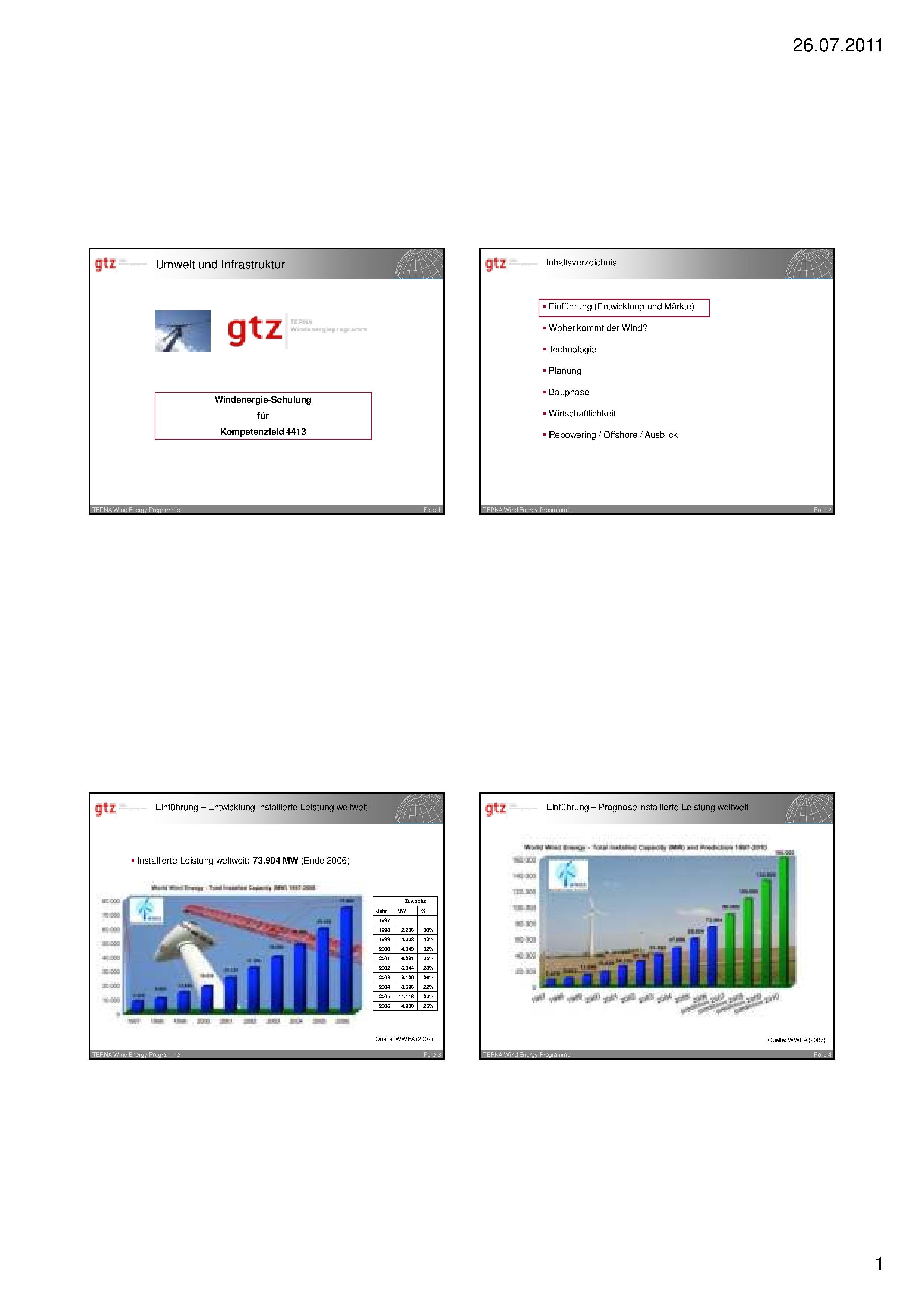Knowledge fuels change
For over a decade, Energypedia has shared free, reliable energy expertise with the world.
We’re now facing a serious funding gap.
Help keep this platform alive — your donation, big or small, truly matters!
Thank you for your support
Difference between revisions of "Capacity Building - Wind Energy"
***** (***** | *****) |
***** (***** | *****) |
||
| Line 121: | Line 121: | ||
<br> <br> <br> | <br> <br> <br> | ||
| + | <br> | ||
| + | <br> | ||
| − | + | <br> | |
Revision as of 07:58, 27 July 2011
Capacity building measures - overview[1]
for instance:
- knowledge transfer
- training for local partner
- energy policy advisory services
- vocational training
- on-the-job e.g. feasibility studies, analysis of wind data
Class-room and on the job training: Wind data measurements
The first phase of measurment of wind data should be accompanied by training measures for partner/local experts/staff.
Content of the trainings should be (among others):
- General introduction into wind energy utilization and -technology
- approach and criteria for site selection
- methods and instruments for wind data measurement
- maintenance of measurement equipment and reading of data
- analysis of wind data
At the end of the training phase, the impacts should be evaluated, e.g. because of an "examination" (test). (cp. also Monitoring)
Wind measurement <10m
Staff of partners will be introduced into operation and maintenance of the equipment, as well as data collection and analysis.
- Subsequent to installation and commissioning of the measurement poles, the staff that is responsible for operation, maintenance and data management, will receive introduction according to their work tasks (Training-On-The-Job).
Content of the introduction::
- Control and, if applicable, error analysis of messearument technology, regular maintenance of the system , documentation of maintenance (log book)
- Clarification of mode of data transfers of raw data and, likely, data analysis with the local experts
Wind measurement > 10m
For wind measurement > 10 m, training content may look as follows:
- increase of wind speed because of height over ground and calculation
- analysis of wind data
- long-term observation and corellation of wind data
- planning wind park layouts, optimization of different types of plants
- wind energy yield prediction
Training example: Capacity Building Wind Energy[2]
Objective of the training:
- Introduction in theoretical basics wind energy utilization
- Introduction wind energy turbine technology
- Planning wind energy projects
- Preparation of internation cooperation in the field of wind energy
- Capacity Building and technology transfer in the field of wind energy
Two Parts:
1. Basic Course "Technology of Wind Power Plants"
2. Advanced Course "Application of Wind Energy"
Basic Course: Introduction into Technology of Wind Power Plants
Content (2-months):
- Introduction into RE, environmental impacts on energy use
- Structure of theChinese energy sector
- RE sectoranalysis
- Wind energy physiscs(maximal power coefficient; Betzmaximum; wind potential)
- Wind measurement and evaluation (anemometer calibration; Weibullparameters, power curve of wind turbines; energy output of a turbine)
- Wind turbine technology
- Transport an erection of a wind turbine
- Rotor design
- Aerodynamic fundamentals
- Blade dimension based(Betz, Schmitz)
- Partial load performance
- Wind tunnel testing
- Structural loads
- Scaling
- Electrical connection
- Blade construction and production
- Dynamic behaviour
- Controlling (different control systems; pich; stall)
- Economic analysis (methods, external costs, comparisonnalysis, sensitivity analysis, dynamic energy production costs)
- Side selection
- Environmental impacts
- Social acceptance
Advanced Course: Application of Wind Energy
Content (3-months course):
- Structural loads and operational parameters
- Design and control concepts of wind turbines
- Planning wind power projects incl. Electrical connection
- Technical concepts of German wind turbines
- Company presentations (AN Bonus, DeWnd, Nordex, REPower, GE Wind, Enercon, Vestas)
- German wind energy market
- Policy and incentives in Germany
- Wind measurement and resource assessment
- Planning wind parks: Siting optimisation, transmission losses, wakeeffects)
- Wind power in complex terrain(Micro-siting)
- Resource assessment (flow models, park calculations)
- Power curve measurements
- Technical requirements for dataloggers
- Environmental impacts of wind power project
- Planning permission procedures and noise measurements
- From financing to take over–practical aspectsof project planning
- Stand alones ystems based on wind and hydropower
- Wind power integration into the electricity supply system and wind integration aspects in China
- Generator systems
- Gridconnections and grid effects
- Results of the German „250 MW wind power programme“
- Grid-relevant wind turbine characteristics given by manufacturers
- Hybrid systems with wind power
Resources
- ↑ parts of content from: GTZ (n.D.): ToR - Leistungsbeschreibung Windmessungen und Windpotentialbestimmung (1. Messphase) Anhang A_ToR 1. Messphase. Eschborn
- ↑ content from InWent/Knecht, Klaus 2005: Capacity Building als Beitrag zur Wirtschaftskooperation mit China im Bereich Windenergie. TERNA-Fachgespräch, 8. März 2005




















